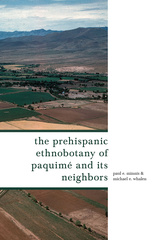The Neighbors of Casas Grandes
Medio Period Communities of Northwestern Chihuahua
By Michael E. Whalen and Paul E. Minnis
The University of Arizona Press
Casas Grandes, or Paquimé, in northwestern Mexico was of one of the few socially complex prehistoric civilizations in North America. Now, based on more than a decade of surveys, excavations, and field work, Michael Whalen and Paul Minnis provide a comprehensive new look at Casas Grandes and its surrounding communities in The Neighbors of Casas Grandes.
This volume provides a fascinating and detailed look into the culture of the Casas Grandes area, involving not just the research of the architecture and artifacts left behind but also the ecology of the area. The authors’ research reveals the complex relationship Casas Grandes had with its neighbors, varying from very direct contact with some communities to more indirect links with others. Important internal influences on the area’s development come to light and population sizes throughout the period demonstrate the absorption of the surrounding populations into Casas Grandes as it reached the peak of its power in the region.
New discoveries suggest the need to revise the previously held beliefs about the age of Casas Grandes and the dates of its rise to power. This ancient civilization may have developed as early as 1180 AD. Such breakthroughs provide fresh insight about not only Casas Grandes but the nearby settlements as well. The Neighbors of Casas Grandes is an important and vital piece of primary field research for all those interested in the Southwest’s archaelogy and history. Its contribution to the knowledge of the Casas Grandes region is monumental in helping us better understand the society that once flourished there.
This volume provides a fascinating and detailed look into the culture of the Casas Grandes area, involving not just the research of the architecture and artifacts left behind but also the ecology of the area. The authors’ research reveals the complex relationship Casas Grandes had with its neighbors, varying from very direct contact with some communities to more indirect links with others. Important internal influences on the area’s development come to light and population sizes throughout the period demonstrate the absorption of the surrounding populations into Casas Grandes as it reached the peak of its power in the region.
New discoveries suggest the need to revise the previously held beliefs about the age of Casas Grandes and the dates of its rise to power. This ancient civilization may have developed as early as 1180 AD. Such breakthroughs provide fresh insight about not only Casas Grandes but the nearby settlements as well. The Neighbors of Casas Grandes is an important and vital piece of primary field research for all those interested in the Southwest’s archaelogy and history. Its contribution to the knowledge of the Casas Grandes region is monumental in helping us better understand the society that once flourished there.
'Whalen and Minnis effectively raise the bar in this extraordinary study that goes far to resolve questions of polity, economy, and community patterning long left unanswered at Casas Grandes.' —Choice
‘This book will become a staple of Southwest archaeology. Whalen and Minnis provide a unique depth of understanding and knowledge about the hamlets, villages, and towns within Casas Grandes’ cultural sway.’ —Paul Fish, co-author of Trincheras Sites in Time, Space, and Society
‘This will become a fundamental resource for Casas Grandes studies, like Di Peso’s volumes.’ —Stephen Lekson, editor of Archaeology of Chaco Canyon: An Eleventh-Century Pueblo Regional Center
Michael E. Whalen is Professor of Anthropology at the University of Tulsa. Paul E. Minnis is Associate Professor of Anthropology at the University of Oklahoma.










